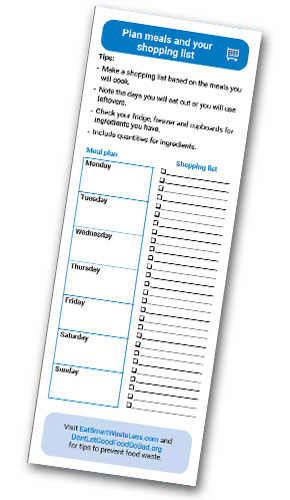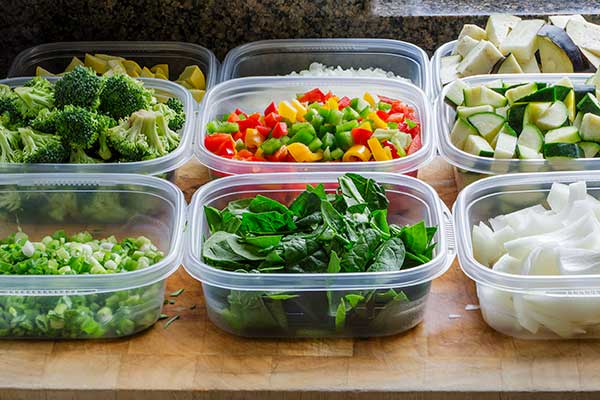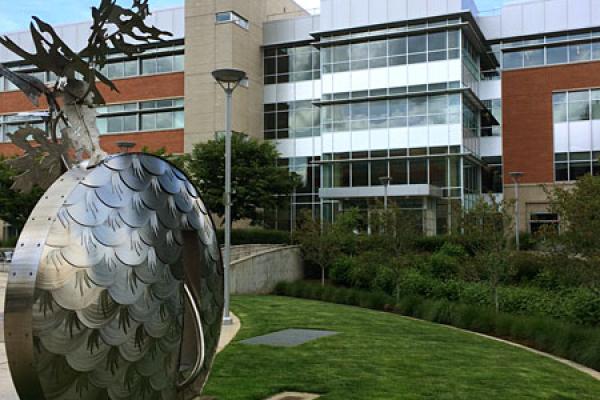Prevent wasted food, repurpose and redistribute, and then dispose to conserve water, energy, and resources.
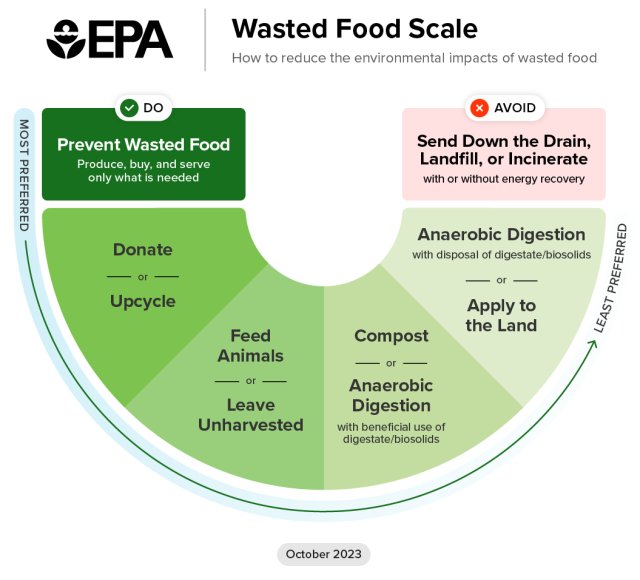 Food is a big part of our daily lives and is important for our health and wellbeing. It's also a major part of the economy, through farming, processing, transporting, storing, and managing food, but the way we produce and use food can negatively affect the environment and society. By making the most of our food—especially by preventing food waste—we can get more benefits and create less harm.
Food is a big part of our daily lives and is important for our health and wellbeing. It's also a major part of the economy, through farming, processing, transporting, storing, and managing food, but the way we produce and use food can negatively affect the environment and society. By making the most of our food—especially by preventing food waste—we can get more benefits and create less harm.
Impacts of Food
 Environmentally, food is one of the most significant materials in our system. It's estimated that 40% of all food produced or imported in the US is never consumed. Annually, 5.9 trillion gallons of freshwater and 140 million acres of agriculture land are wasted on food that is never consumed. Food in landfills also account for 58% of greenhouse gas emissions, and in Oregon, represent 16% of material in our landfills (Oregon DEQ). The impacts of food waste add up and it doesn't only impact our environment, it also wastes labor, energy, resources, and money along the way.
Environmentally, food is one of the most significant materials in our system. It's estimated that 40% of all food produced or imported in the US is never consumed. Annually, 5.9 trillion gallons of freshwater and 140 million acres of agriculture land are wasted on food that is never consumed. Food in landfills also account for 58% of greenhouse gas emissions, and in Oregon, represent 16% of material in our landfills (Oregon DEQ). The impacts of food waste add up and it doesn't only impact our environment, it also wastes labor, energy, resources, and money along the way.
Prevent Wasted Food
Preventing food waste is one of the most impactful ways you can reduce environmental impacts and save money. Did you know that each year, the average family of four spends over $2,900 on food that never gets consumed?
Below are a few steps you/your household could consider to start making small changes to how you shop, store, and think about making your food last longer. Start small, add as you can, and find a plan that works for your situation – any little bit helps.
1. Shop with Meals in Mind
- Keep a list of meals that your household enjoys.
- Make a meal plan each week. Take into account the days when you will eat out or eat up leftovers instead of cooking.
- Keep track of your meals and lists. AnyList, BigOven, Cozi, Cooklist, Mealime, Prepear, and Samsung Food and offer free versions of their apps to track recipes and create shopping lists.
- Note: the county does not endorse nor particularly support any of these apps or websites.
- Utilize The Guest-imator when planning for larger events or holidays to determine how much food to prepare.
Shop at home first
- Make a shopping list based on your meal plan. Include quantities to make sure you buy just what you need.
- Check the fridge, freezer and cupboards for ingredients you already have before you buy more.
- Download this simple meal planner and shopping list.
Stick to your plan
- Hungry? Eat a snack before shopping to avoid impulse purchases.
- Buy only what you need. Pre-packaged produce or 2-for-1 deals can lead to over-buying and wasted food. Shop the loose produce area and dry goods bulk section to get the exact amount you need.
- If you eat fresh foods often, try shopping a little more frequently, but buy less each trip. This way your food is always fresh.
- Buy fruit with varying ripeness so eating can be staggered.
- When choosing produce, imperfect fruits and veggies are often perfectly delicious. When choosing bananas, go for the often-ignored singles and doubles.
2. Prepare Now to Eat Later
Prep right from the store
- As soon as you return from the store, wash, chop, peel, cook or portion ingredients for your weekly meals and snacks. Alternatively, choose a specific day each week for food prep.
- Some items, like berries and cabbage, should not be washed until they are ready to eat.
- If portioning canned goods, transfer food to suitable containers with lids. Do not store food in opened metal cans.
Freeze food for later
- Freeze food such as bread, sliced fruit, cut-up vegetables and meat in meal-size portions if you don't plan to use them within a few days.
- If you've made too much or if leftovers are not going to be eaten in time, freeze them in a freezer-safe container for use later when you need a quick meal.
- Store prepped food in clear containers and place near the front of the refrigerator so they are visible and easy to identify.
- Freezer bags or containers with a good seal can be used to avoid freezer burn.
- Label and date food containers and bags when storing.
- Keep labels or masking tape and a pen nearby to make labeling as convenient as possible.
3. Keep it Fresh
- Fruits and vegetables each have their own storage requirements for the longest life. Find food storage tips using the following resources:
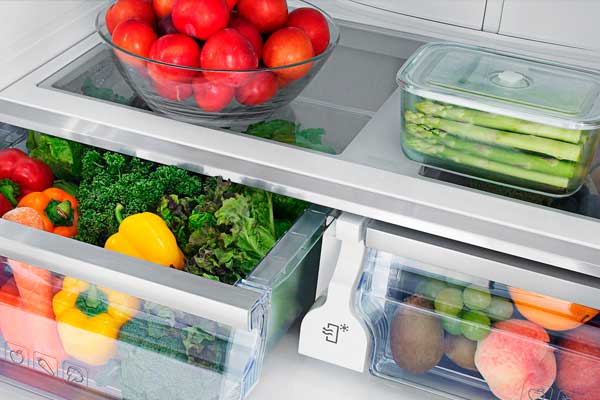 Put fruits that need to ripen such as peaches, plums, avocados and tomatoes in a bowl on the counter until ripe. Once ripe, move produce to the refrigerator.
Put fruits that need to ripen such as peaches, plums, avocados and tomatoes in a bowl on the counter until ripe. Once ripe, move produce to the refrigerator.- Unsure if your food is still okay to eat? Find out at Eat or Toss.
Keep it separated
- Be careful when storing apples, pears, tomatoes and bananas with other fruit — they emit ethylene, a gas that accelerates ripening. Check fruit regularly. Separate very ripe fruit, such as apples and bananas, from your other produce.
- When cooking meals with multiple ingredients like vegetables, proteins and grains, consider storing them separately. This offers more flexibility when making new meals from those leftovers.
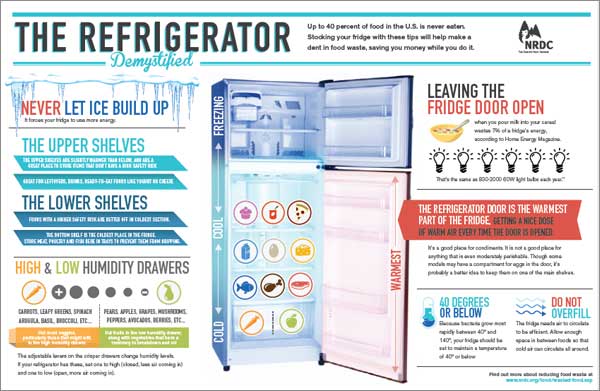 Additional tips
Additional tips
Most refrigerators have specific design elements to maximize the lifespan of your food. Understand your refrigerator's design and see where and how you should be storing your food.
4. Eat What You Buy
Keep track of leftovers
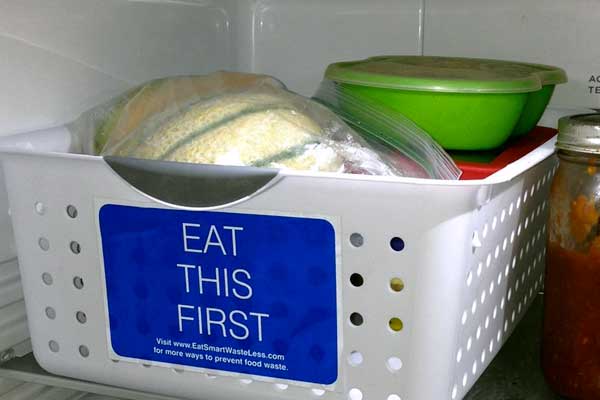 First In, First Out (FIFO) is a useful way that many restaurants and grocery stores use to organize food - and you can use this system at home! Move food that's soonest to spoil to the front of the shelf or put it in an "Eat this first" bin. Move recently purchased items towards the back.
First In, First Out (FIFO) is a useful way that many restaurants and grocery stores use to organize food - and you can use this system at home! Move food that's soonest to spoil to the front of the shelf or put it in an "Eat this first" bin. Move recently purchased items towards the back.- Make leftovers a part of your weekly meal plan by designating one day a week for 'eating down the fridge' or 'leftover lollapalooza'.
- If possible, reheat leftovers in the way they were originally prepared. A toaster oven can help make pizza, breads, fried foods, grilled meats, and seafood much more appetizing than the microwave can.
Get creative
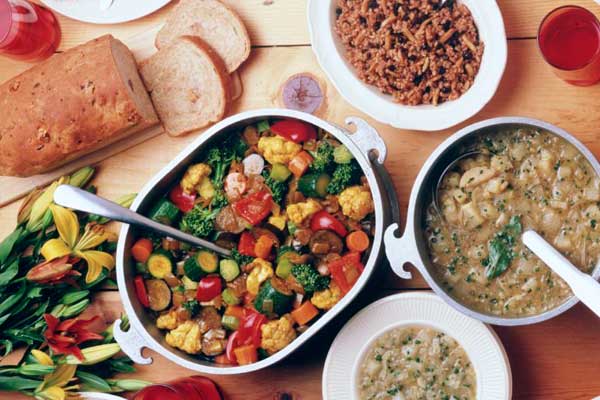 Think of leftovers as ingredients. Make casseroles, burritos, wraps, frittatas, stews, smoothies and more from leftovers and extra ingredients. Find ideas for leftovers at the Food Hero website.
Think of leftovers as ingredients. Make casseroles, burritos, wraps, frittatas, stews, smoothies and more from leftovers and extra ingredients. Find ideas for leftovers at the Food Hero website.- Puree cooked veggies and a can of tomato sauce for a nutrient dense pasta sauce or puree with a can of broth for soup.
- Learn cooking skills together and challenge family members to transform 'need to use up' food items into a meal.
- Utilize various preservation techniques, such as dehydrating, canning, freezing, pickling, and infusing to save food from being wasted.
Don't be confused by the date labels
- Get to know what date labels mean so you aren't throwing good food in the trash. "Sell-by", "use-by" and "best by" all means different things and none of these identify when food has 'gone bad' or could be dangerous.
- Practice safe food handling habits, store food properly, and learn when and how to use your senses and good judgment to determine if food needs to be tossed.
- Food shelf life estimates are helpful guides. However, they are just estimates so always use your best judgment.
5. Measure Wasted Food
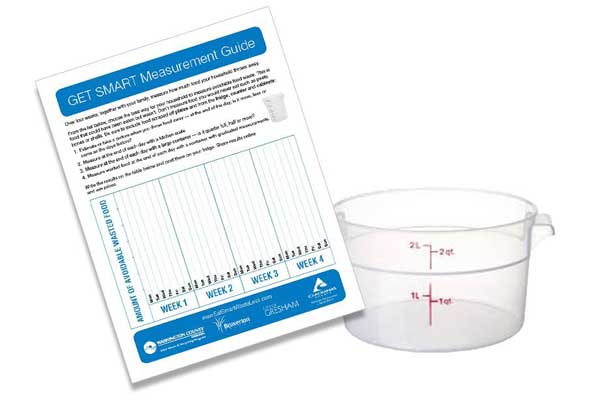 Consider measuring the food your household throws away. Identify food that was once edible – not peelings, cores or eggshells. Be sure to include food scraped off plates and tossed from the fridge, counter and cabinets. For any duration, choose a measurement method that works best for you from the options below:
Consider measuring the food your household throws away. Identify food that was once edible – not peelings, cores or eggshells. Be sure to include food scraped off plates and tossed from the fridge, counter and cabinets. For any duration, choose a measurement method that works best for you from the options below:- Take a picture or make an estimate, is it more, less or the same as the week before?
- Weigh it. Using a kitchen scale, weigh wasted food on a regular basis and write it down.
- Track the volume. Using a large container, estimate how full is it — quarter full, half or more. Or use a container with graduated measurements.
- Write the results on the Measurement Guide and share with those in your household. Remember to note the reason the food was wasted so you can identify opportunities for improvement.
Start by making changes in the way you shop for, prepare, and store your food. Small actions can make a big difference!
Request free physical resources for preventing wasted food by emailing wasteinfo@clackamas.us.
Rescue and Donate Food
- Save good food from going to waste! Pickup surplus food from nearby stores and restaurants through Too Good To Go.
- Start or donate to a Little Free Pantry in your neighborhood.
- Donate surplus to local food pantries or Gleaners of Clackamas County.
Compost
When it comes to peels, shells, bones, and coffee grounds, (and more), disposal is inevitable. Use various at-home composting methods (compost tumblers, stationary compost bins, worm bins, etc.) to decompose your food scraps. Find more information and tips on home composting through Metro or OSU Extension Service's Master Gardener program.
Residents within the city limits of Lake Oswego, Milwaukie, and Wilsonville can include food waste in their yard waste bins. Including food waste in your yard waste bin outside those city limits may result in a fee from your garbage and recycling company.
Learn more on our Recycle Guide page.
 Translate
Translate







